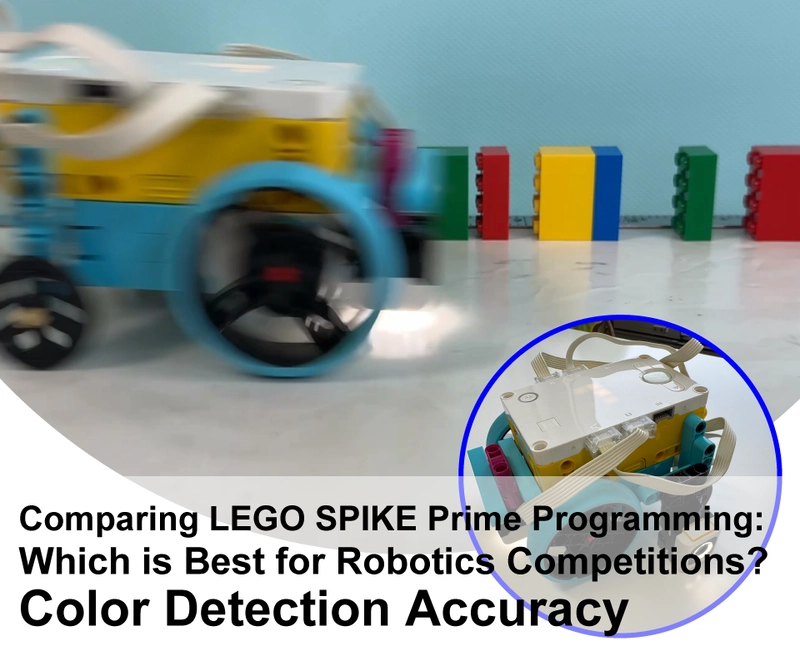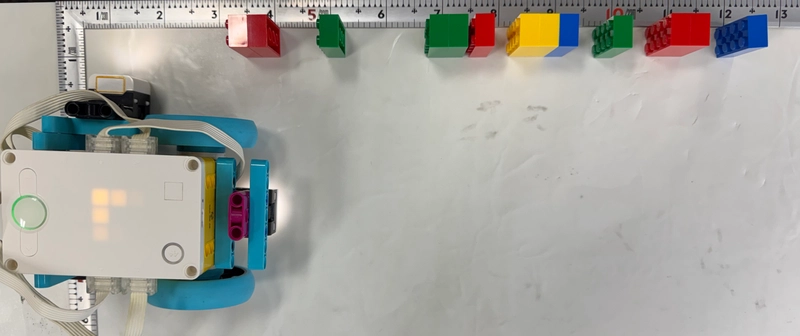Comparing LEGO SPIKE Prime Programming: Which Is Best for Robotics Competitions? - 4 : Color Detection Accuracy
When participating in a robotics contest using LEGO SPIKE Prime, choosing the right programming environment can impact performance. In this experiment, we tested how accurately different programming environments detect colors while the robot is in motion. Tested Programming Environments I compared the following four environments: Word Blocks (SPIKE App 3) → Download here Python (SPIKE App 3) → Download here Python (Pybricks) → More info C Language (spike-rt) → GitHub repository Robot Configuration For the test, I used a car-type robot with the following setup: Left wheel motor: Port A Right wheel motor: Port B Side-facing color sensor: Port C Downward-facing color sensor: Port D Test Method To compare the environments, I conducted the following test: The side-facing color sensor detects various block colors while the robot moves. The downward-facing color sensor detects black and stops the robot. Each environment was tested five times, and the average results were compared. Programs were optimized for each environment while keeping the movement speed nearly the same. Word Blocks (SPIKE App 3) Python (SPIKE App 3) # Set up all devices LineSensor = port.D ColorSensor = port.C colors = [] color_now = None # Color reading task async def color_task(): global color_now while True: color_now = color_sensor.color(ColorSensor) await runloop.sleep_ms(1) async def main(): global colors global color_now motor_pair.pair(motor_pair.PAIR_1, port.A, port.B) motor_pair.move(motor_pair.PAIR_1, 0, velocity=900) while color_sensor.reflection(LineSensor) > 50: if len(colors) == 0 or color_now != colors[-1]: colors.append(color_now) await runloop.sleep_ms(1) motor_pair.stop(motor_pair.PAIR_1, stop=motor.BRAKE) print(colors) runloop.run(color_task(), main()) Python (Pybricks) # Set up all devices. hub = PrimeHub() left_motor = Motor(Port.A, Direction.COUNTERCLOCKWISE) right_motor = Motor(Port.B, Direction.CLOCKWISE) line_sensor = ColorSensor(Port.D) color_sensor = ColorSensor(Port.C) # Variables for color detection color_now = None colors = [] # Color reading task async def color_task(): global color_now while True: color_now = await color_sensor.color(surface=True) await wait(1) async def run(): global colors global color_now # start moving left_motor.run(900) right_motor.run(900) while await line_sensor.reflection() > 50: if len(colors) == 0 or color_now != colors[-1]: colors.append(color_now) await wait(1) left_motor.brake() right_motor.brake() print(colors) async def main(): await multitask(color_task(), run()) run_task(main()) C Language (spike-rt) pup_motor_t *motorA; pup_motor_t *motorB; pup_device_t *ColorSensor; pup_device_t *LineSensor; char colors[30]; // Array to store detected colors char color_now; void Main(intptr_t exinf) { motorA = pup_motor_init(PBIO_PORT_ID_A, PUP_DIRECTION_COUNTERCLOCKWISE); motorB = pup_motor_init(PBIO_PORT_ID_B, PUP_DIRECTION_CLOCKWISE); LineSensor = pup_color_sensor_get_device(PBIO_PORT_ID_D); ColorSensor= pup_color_sensor_get_device(PBIO_PORT_ID_C); int8_t i = 0; // Wait for left button to be pressed hub_button_t pressed; while(!(pressed&HUB_BUTTON_LEFT)){ hub_button_is_pressed(&pressed); hub_light_on_color(PBIO_COLOR_GREEN); } sta_cyc(CYC_HDR); // Start color_task // Start moving pup_motor_set_speed(motorA,900); pup_motor_set_speed(motorB,900); // Add detected colors to the array while (pup_color_sensor_reflection(LineSensor) > 50 ) { if (i == 0 || color_now != colors[i-1]) { if (i < sizeof(colors) - 1) { colors[i] = color_now; i++; } } } // Stop moving pup_motor_stop(motorA); pup_motor_stop(motorB); stp_cyc(CYC_HDR); // Stop color_task // Output the colors detected int8_t j; for (j = 0; j < 30; j++) { syslog(LOG_NOTICE, "%d : %c", j, colors[j]); } } // Read color every 1ms void color_task(intptr_t exinf) { color_now = pup_color_sensor_color_name(ColorSensor, true); } The robot and block placement during the test: Expected color detection sequence: None → Red → None → Green → None → Green → Red → None → Yellow → Blue → None → Green → None → Red → None → Blue → None Results: Which Environment Was Most Accurate? The environment with the least misdetections was C Language (spike-rt): 1.2% - C Language (spike-rt) 2.5% - Python (Pybricks) 3.22% - Word Block (SPIKE App3) 4.27% - Python (SPIKE App3) Observed Trends Word Block & Python (SPIKE App3): More likely to misdetect colors when changing to/from green (often detecting light blue or black by mistake). More likely to misdetect white when changing from yellow. More likely to misdetect light blue when changing from blue.


When participating in a robotics contest using LEGO SPIKE Prime, choosing the right programming environment can impact performance. In this experiment, we tested how accurately different programming environments detect colors while the robot is in motion.
Tested Programming Environments
I compared the following four environments:
- Word Blocks (SPIKE App 3) → Download here
- Python (SPIKE App 3) → Download here
- Python (Pybricks) → More info
- C Language (spike-rt) → GitHub repository
Robot Configuration
For the test, I used a car-type robot with the following setup:
- Left wheel motor: Port A
- Right wheel motor: Port B
- Side-facing color sensor: Port C
- Downward-facing color sensor: Port D
Test Method
To compare the environments, I conducted the following test:
- The side-facing color sensor detects various block colors while the robot moves.
- The downward-facing color sensor detects black and stops the robot.
- Each environment was tested five times, and the average results were compared.
- Programs were optimized for each environment while keeping the movement speed nearly the same.
Word Blocks (SPIKE App 3)
Python (SPIKE App 3)
# Set up all devices
LineSensor = port.D
ColorSensor = port.C
colors = []
color_now = None
# Color reading task
async def color_task():
global color_now
while True:
color_now = color_sensor.color(ColorSensor)
await runloop.sleep_ms(1)
async def main():
global colors
global color_now
motor_pair.pair(motor_pair.PAIR_1, port.A, port.B)
motor_pair.move(motor_pair.PAIR_1, 0, velocity=900)
while color_sensor.reflection(LineSensor) > 50:
if len(colors) == 0 or color_now != colors[-1]:
colors.append(color_now)
await runloop.sleep_ms(1)
motor_pair.stop(motor_pair.PAIR_1, stop=motor.BRAKE)
print(colors)
runloop.run(color_task(), main())
Python (Pybricks)
# Set up all devices.
hub = PrimeHub()
left_motor = Motor(Port.A, Direction.COUNTERCLOCKWISE)
right_motor = Motor(Port.B, Direction.CLOCKWISE)
line_sensor = ColorSensor(Port.D)
color_sensor = ColorSensor(Port.C)
# Variables for color detection
color_now = None
colors = []
# Color reading task
async def color_task():
global color_now
while True:
color_now = await color_sensor.color(surface=True)
await wait(1)
async def run():
global colors
global color_now
# start moving
left_motor.run(900)
right_motor.run(900)
while await line_sensor.reflection() > 50:
if len(colors) == 0 or color_now != colors[-1]:
colors.append(color_now)
await wait(1)
left_motor.brake()
right_motor.brake()
print(colors)
async def main():
await multitask(color_task(), run())
run_task(main())
C Language (spike-rt)
pup_motor_t *motorA;
pup_motor_t *motorB;
pup_device_t *ColorSensor;
pup_device_t *LineSensor;
char colors[30]; // Array to store detected colors
char color_now;
void Main(intptr_t exinf)
{
motorA = pup_motor_init(PBIO_PORT_ID_A, PUP_DIRECTION_COUNTERCLOCKWISE);
motorB = pup_motor_init(PBIO_PORT_ID_B, PUP_DIRECTION_CLOCKWISE);
LineSensor = pup_color_sensor_get_device(PBIO_PORT_ID_D);
ColorSensor= pup_color_sensor_get_device(PBIO_PORT_ID_C);
int8_t i = 0;
// Wait for left button to be pressed
hub_button_t pressed;
while(!(pressed&HUB_BUTTON_LEFT)){
hub_button_is_pressed(&pressed);
hub_light_on_color(PBIO_COLOR_GREEN);
}
sta_cyc(CYC_HDR); // Start color_task
// Start moving
pup_motor_set_speed(motorA,900);
pup_motor_set_speed(motorB,900);
// Add detected colors to the array
while (pup_color_sensor_reflection(LineSensor) > 50 ) {
if (i == 0 || color_now != colors[i-1]) {
if (i < sizeof(colors) - 1) {
colors[i] = color_now;
i++;
}
}
}
// Stop moving
pup_motor_stop(motorA);
pup_motor_stop(motorB);
stp_cyc(CYC_HDR); // Stop color_task
// Output the colors detected
int8_t j;
for (j = 0; j < 30; j++) {
syslog(LOG_NOTICE, "%d : %c", j, colors[j]);
}
}
// Read color every 1ms
void color_task(intptr_t exinf)
{
color_now = pup_color_sensor_color_name(ColorSensor, true);
}
Expected color detection sequence:
None → Red → None → Green → None → Green → Red → None → Yellow → Blue → None → Green → None → Red → None → Blue → None
Results: Which Environment Was Most Accurate?
The environment with the least misdetections was C Language (spike-rt):
1.2% - C Language (spike-rt)
2.5% - Python (Pybricks)
3.22% - Word Block (SPIKE App3)
4.27% - Python (SPIKE App3)
Observed Trends
Word Block & Python (SPIKE App3):
- More likely to misdetect colors when changing to/from green (often detecting light blue or black by mistake).
- More likely to misdetect white when changing from yellow.
- More likely to misdetect light blue when changing from blue.
- Seemed to detect background colors instead of "None" when the object’s color was ambiguous or distant.
Pybricks & C (spike-rt):
- More likely to misdetect yellow when changing from green.
- More likely to misdetect white when changing from yellow.
Want to Try C Programming on LEGO SPIKE Prime?
If you’re interested in trying C on SPIKE Prime, there are beginner-friendly learning materials available. As of March 2025, a trial version is also accessible—give it a try!
Related Articles
- Testing LEGO SPIKE Prime with C: Line Follower Speed & Stability
- Introducing SPIKE-RT: the C Language Software Platform for LEGO SPIKE Prime
- Comparing LEGO SPIKE Prime Programming: Which is Best for Robotics Competitions? - 1
- Comparing LEGO SPIKE Prime Programming: Which Is Best for Robotics Competitions? - 2
- Comparing LEGO SPIKE Prime Programming: Which Is Best for Robotics Competitions? - 3




















































%20Abstract%20Background%20112024%20SOURCE%20Amazon.jpg)






















































































































![[The AI Show Episode 142]: ChatGPT’s New Image Generator, Studio Ghibli Craze and Backlash, Gemini 2.5, OpenAI Academy, 4o Updates, Vibe Marketing & xAI Acquires X](https://www.marketingaiinstitute.com/hubfs/ep%20142%20cover.png)
























































































































































































































































-Nintendo-Switch-2-–-Overview-trailer-00-00-10.png?width=1920&height=1920&fit=bounds&quality=80&format=jpg&auto=webp#)





















_Anna_Berkut_Alamy.jpg?#)













































































































![YouTube Announces New Creation Tools for Shorts [Video]](https://www.iclarified.com/images/news/96923/96923/96923-640.jpg)





































































![[Weekly funding roundup March 29-April 4] Steady-state VC inflow pre-empts Trump tariff impact](https://images.yourstory.com/cs/2/220356402d6d11e9aa979329348d4c3e/WeeklyFundingRoundupNewLogo1-1739546168054.jpg)

































































